engine oil SKODA FABIA 2004 1.G / 6Y Owner's Guide
[x] Cancel search | Manufacturer: SKODA, Model Year: 2004, Model line: FABIA, Model: SKODA FABIA 2004 1.G / 6YPages: 247
Page 189 of 247
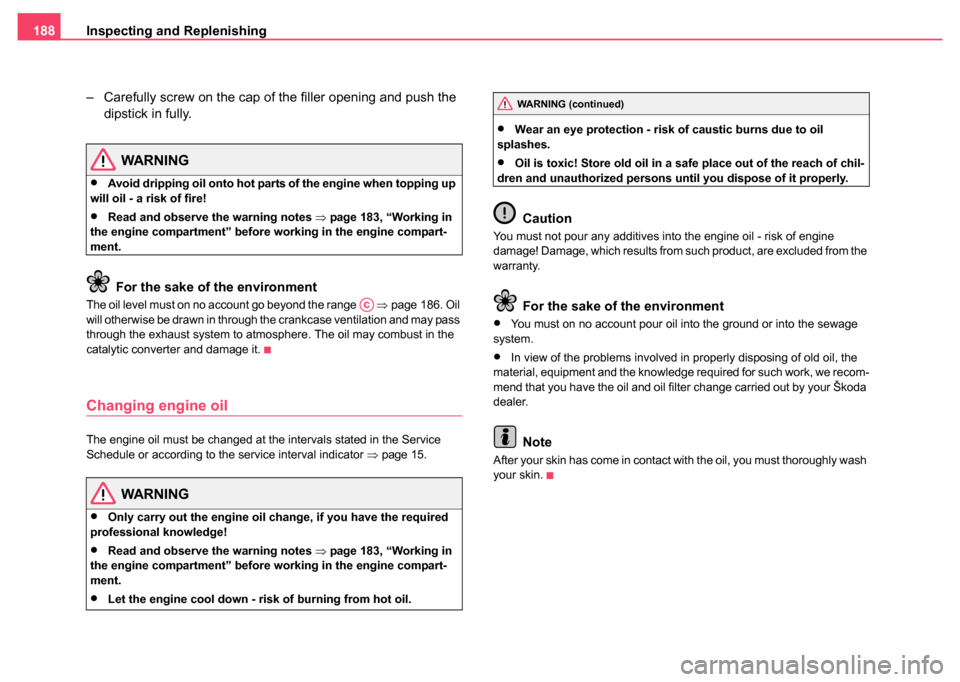
Inspecting and Replenishing
188
– Carefully screw on the cap of the filler opening and push the dipstick in fully.
WARNING
•Avoid dripping oil onto hot parts of the engine when topping up
will oil - a risk of fire!
•Read and observe the warning notes ⇒page 183, “Working in
the engine compartment” before working in the engine compart-
ment.
For the sake of the environment
The oil level must on no account go beyond the range ⇒page 186. Oil
will otherwise be drawn in through the crankcase ventilation and may pass
through the exhaust system to atmosphere. The oil may combust in the
catalytic converter and damage it.
Changing engine oil
The engine oil must be changed at the intervals stated in the Service
Schedule or according to the service interval indicator ⇒page 15.
WARNING
•Only carry out the engine oil change, if you have the required
professional knowledge!
•Read and observe the warning notes ⇒page 183, “Working in
the engine compartment” before working in the engine compart-
ment.
•Let the engine cool down - risk of burning from hot oil.
•Wear an eye protection - risk of caustic burns due to oil
splashes.
•Oil is toxic! Store old oil in a safe place out of the reach of chil-
dren and unauthorized persons until you dispose of it properly.
Caution
You must not pour any additives into the engine oil - risk of engine
damage! Damage, which results from such product, are excluded from the
warranty.
For the sake of the environment
•You must on no account pour oil into the ground or into the sewage
system.
•In view of the problems involved in properly disposing of old oil, the
material, equipment and the knowledge required for such work, we recom-
mend that you have the oil and oil filter change carried out by your Škoda
dealer.
Note
After your skin has come in contact with the oil, you must thoroughly wash
your skin.
Ac
WARNING (continued)
Page 190 of 247
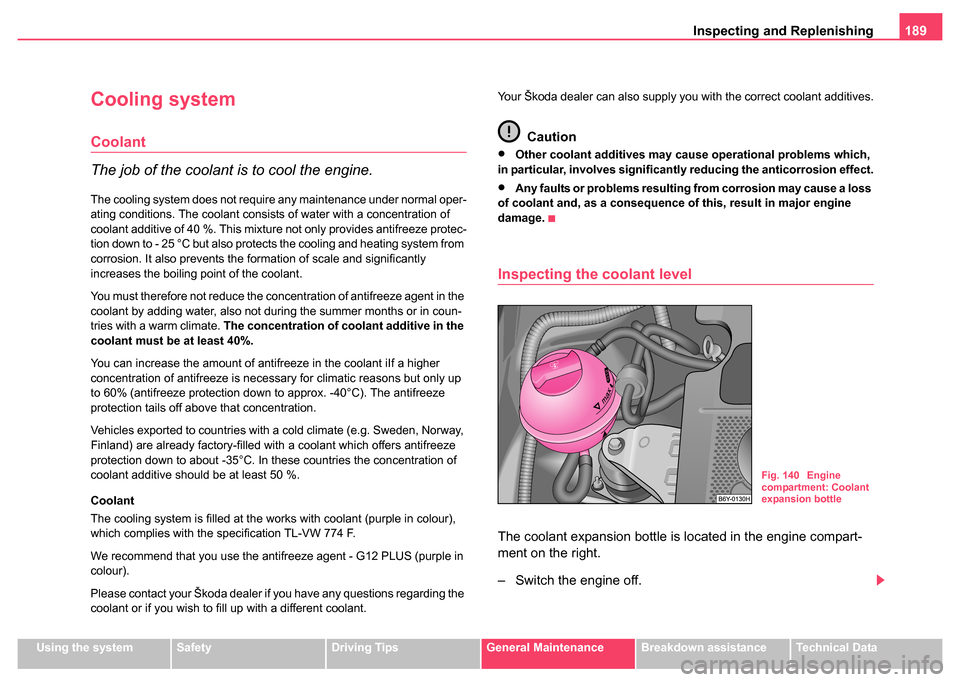
Inspecting and Replenishing189
Using the systemSafetyDriving TipsGeneral MaintenanceBreakdown assistanceTechnical Data
Cooling system
Coolant
The job of the coolant is to cool the engine.
The cooling system does not require any maintenance under normal oper-
ating conditions. The coolant consists of water with a concentration of
coolant additive of 40 %. This mixture not only provides antifreeze protec-
tion down to - 25 °C but also protects the cooling and heating system from
corrosion. It also prevents the formation of scale and significantly
increases the boiling point of the coolant.
You must therefore not reduce the concentration of antifreeze agent in the
coolant by adding water, also not during the summer months or in coun-
tries with a warm climate. The concentration of coolant additive in the
coolant must be at least 40%.
You can increase the amount of antifreeze in the coolant iIf a higher
concentration of antifreeze is necessary for climatic reasons but only up
to 60% (antifreeze protection down to approx. -40°C). The antifreeze
protection tails off above that concentration.
Vehicles exported to countries with a cold climate (e.g. Sweden, Norway,
Finland) are already factory-filled with a coolant which offers antifreeze
protection down to about -35°C. In these countries the concentration of
coolant additive should be at least 50 %.
Coolant
The cooling system is filled at the works with coolant (purple in colour),
which complies with the specification TL-VW 774 F.
We recommend that you use the antifreeze agent - G12 PLUS (purple in
colour).
Please contact your Škoda dealer if you have any questions regarding the
coolant or if you wish to fill up with a different coolant. Your Škoda dealer can also supply you with the correct coolant additives.
Caution
•Other coolant additives may cause operational problems which,
in particular, involves significantly reducing the anticorrosion effect.
•Any faults or problems resulting from corrosion may cause a loss
of coolant and, as a consequence of this, result in major engine
damage.
Inspecting the coolant level
The coolant expansion bottle is located in the engine compart-
ment on the right.
– Switch the engine off.
Fig. 140 Engine
compartment: Coolant
expansion bottle
Page 191 of 247
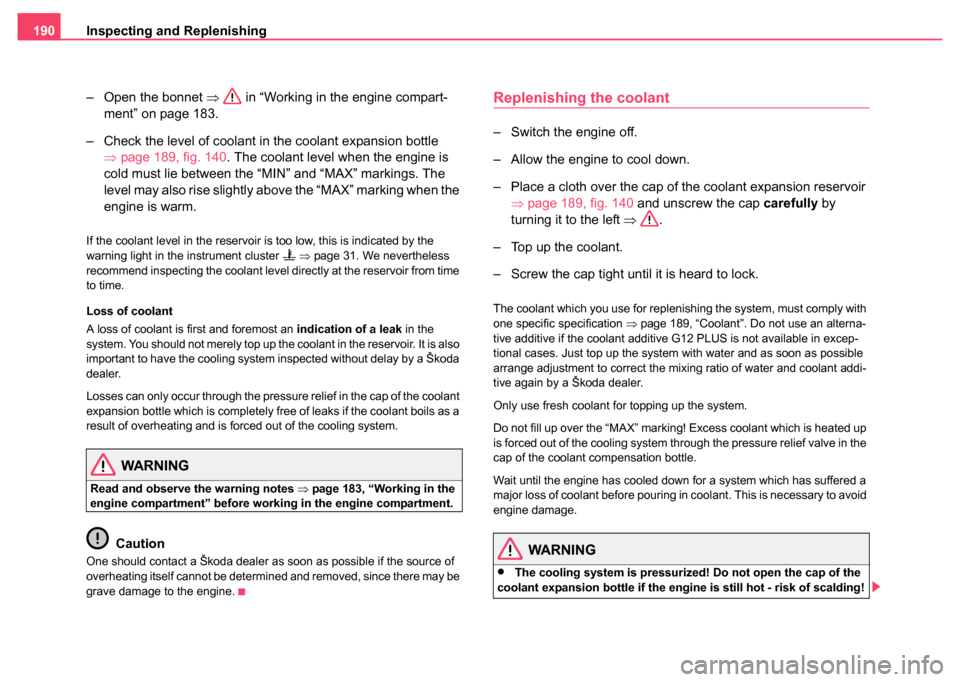
Inspecting and Replenishing
190
– Open the bonnet ⇒ in “Working in the engine compart-
ment” on page 183.
– Check the level of coolant in the coolant expansion bottle ⇒page 189, fig. 140. The coolant level when the engine is
cold must lie between the “MIN” and “MAX” markings. The
level may also rise slightly above the “MAX” marking when the
engine is warm.
If the coolant level in the reservoir is too low, this is indicated by the
warning light in the instrument cluster ⇒ page 31. We nevertheless
recommend inspecting the coolant level directly at the reservoir from time
to time.
Loss of coolant
A loss of coolant is first and foremost an indication of a leak in the
system. You should not merely top up the coolant in the reservoir. It is also
important to have the cooling system inspected without delay by a Škoda
dealer.
Losses can only occur through the pressure relief in the cap of the coolant
expansion bottle which is completely free of leaks if the coolant boils as a
result of overheating and is forced out of the cooling system.
WARNING
Read and observe the warning notes ⇒page 183, “Working in the
engine compartment” before working in the engine compartment.
Caution
One should contact a Škoda dealer as soon as possible if the source of
overheating itself cannot be determined and removed, since there may be
grave damage to the engine.
Replenishing the coolant
– Switch the engine off.
– Allow the engine to cool down.
– Place a cloth over the cap of the coolant expansion reservoir ⇒page 189, fig. 140 and unscrew the cap carefully by
turning it to the left ⇒.
– Top up the coolant.
– Screw the cap tight until it is heard to lock.
The coolant which you use for replenishing the system, must comply with
one specific specification ⇒page 189, “Coolant”. Do not use an alterna-
tive additive if the coolant additive G12 PLUS is not available in excep-
tional cases. Just top up the system with water and as soon as possible
arrange adjustment to correct the mixing ratio of water and coolant addi-
tive again by a Škoda dealer.
Only use fresh coolant for topping up the system.
Do not fill up over the “MAX” marking! Excess coolant which is heated up
is forced out of the cooling system through the pressure relief valve in the
cap of the coolant compensation bottle.
Wait until the engine has cooled down for a system which has suffered a
major loss of coolant before pouring in coolant. This is necessary to avoid
engine damage.
WARNING
•The cooling system is pressurized! Do not open the cap of the
coolant expansion bottle if the engi ne is still hot - risk of scalding!
Page 193 of 247
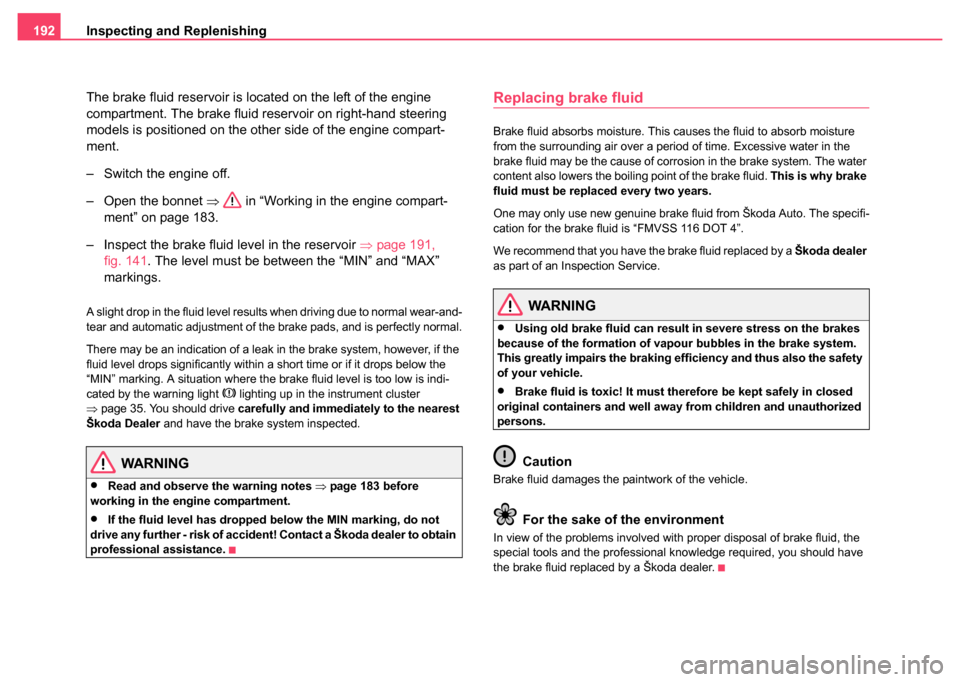
Inspecting and Replenishing
192
The brake fluid reservoir is located on the left of the engine
compartment. The brake fluid reservoir on right-hand steering
models is positioned on the other side of the engine compart-
ment.
– Switch the engine off.
– Open the bonnet ⇒ in “Working in the engine compart-
ment” on page 183.
– Inspect the brake fluid level in the reservoir ⇒page 191,
fig. 141. The level must be between the “MIN” and “MAX”
markings.
A slight drop in the fluid level results when driving due to normal wear-and-
tear and automatic adjustment of the brake pads, and is perfectly normal.
There may be an indication of a leak in the brake system, however, if the
fluid level drops significantly within a short time or if it drops below the
“MIN” marking. A situation where the brake fluid level is too low is indi-
cated by the warning light
lighting up in the instrument cluster
⇒ page 35. You should drive carefully and immediately to the nearest
Škoda Dealer and have the brake system inspected.
WARNING
•Read and observe the warning notes ⇒page 183 before
working in the engine compartment.
•If the fluid level has dropped below the MIN marking, do not
drive any further - risk of accident! Contact a Škoda dealer to obtain
professional assistance.
Replacing brake fluid
Brake fluid absorbs moisture. This causes the fluid to absorb moisture
from the surrounding air over a period of time. Excessive water in the
brake fluid may be the cause of corrosion in the brake system. The water
content also lowers the boiling point of the brake fluid. This is why brake
fluid must be replaced every two years.
One may only use new genuine brake fluid from Škoda Auto. The specifi-
cation for the brake fluid is “FMVSS 116 DOT 4”.
We recommend that you have the brake fluid replaced by a Škoda dealer
as part of an Inspection Service.
WARNING
•Using old brake fluid can result in severe stress on the brakes
because of the formation of vapour bubbles in the brake system.
This greatly impairs the braking efficiency and thus also the safety
of your vehicle.
•Brake fluid is toxic! It must therefore be kept safely in closed
original containers and well away from children and unauthorized
persons.
Caution
Brake fluid damages the paintwork of the vehicle.
For the sake of the environment
In view of the problems involved with proper disposal of brake fluid, the
special tools and the professional knowledge required, you should have
the brake fluid replaced by a Škoda dealer.
Page 207 of 247
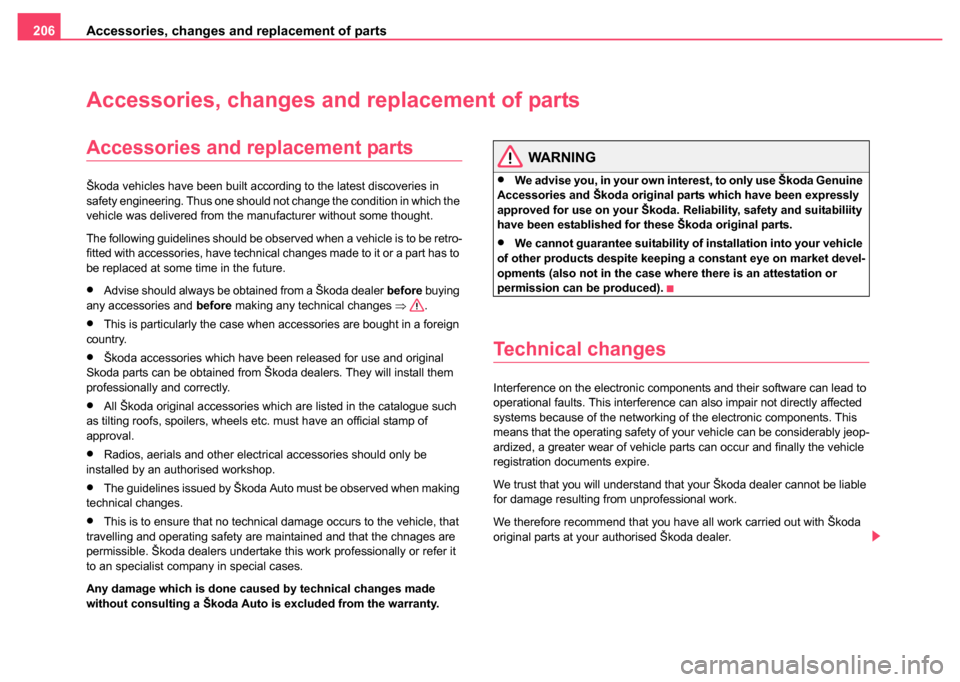
Accessories, changes and replacement of parts
206
Accessories, changes an d replacement of parts
Accessories and replacement parts
Škoda vehicles have been built according to the latest discoveries in
safety engineering. Thus one should not change the condition in which the
vehicle was delivered from the manufacturer without some thought.
The following guidelines should be observed when a vehicle is to be retro-
fitted with accessories, have technical changes made to it or a part has to
be replaced at some time in the future.
•Advise should always be obtained from a Škoda dealer before buying
any accessories and before making any technical changes ⇒.
•This is particularly the case when accessories are bought in a foreign
country.
•Škoda accessories which have been released for use and original
Skoda parts can be obtained from Škoda dealers. They will install them
professionally and correctly.
•All Škoda original accessories which are listed in the catalogue such
as tilting roofs, spoilers, wheels etc. must have an official stamp of
approval.
•Radios, aerials and other electrical accessories should only be
installed by an authorised workshop.
•The guidelines issued by Škoda Auto must be observed when making
technical changes.
•This is to ensure that no technical damage occurs to the vehicle, that
travelling and operating safety are maintained and that the chnages are
permissible. Škoda dealers undertake this work professionally or refer it
to an specialist company in special cases.
Any damage which is done caused by technical changes made
without consulting a Škoda Auto is excluded from the warranty.
WARNING
•We advise you, in your own interest, to only use Škoda Genuine
Accessories and Škoda original parts which have been expressly
approved for use on your Škoda. Reliability, safety and suitabiliity
have been established for these Škoda original parts.
•We cannot guarantee suitability of installation into your vehicle
of other products despite keeping a constant eye on market devel-
opments (also not in the case where there is an attestation or
permission can be produced).
Technical changes
Interference on the electronic components and their software can lead to
operational faults. This interference can also impair not directly affected
systems because of the networking of the electronic components. This
means that the operating safety of your vehicle can be considerably jeop-
ardized, a greater wear of vehicle parts can occur and finally the vehicle
registration documents expire.
We trust that you will understand that your Škoda dealer cannot be liable
for damage resulting from unprofessional work.
We therefore recommend that you have all work carried out with Škoda
original parts at your authorised Škoda dealer.
Page 214 of 247
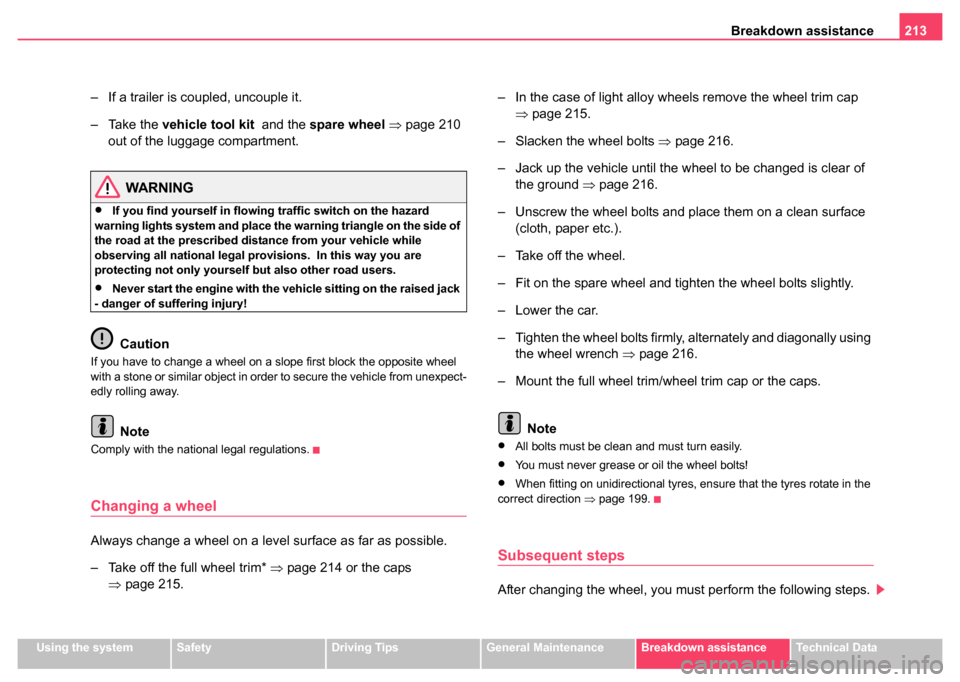
Breakdown assistance213
Using the systemSafetyDriving TipsGeneral MaintenanceBreakdown assistanceTechnical Data
– If a trailer is coupled, uncouple it.
– Take the vehicle tool kit and the spare wheel ⇒ page 210
out of the luggage compartment.
WARNING
•If you find yourself in flowing traffic switch on the hazard
warning lights system and place the warning triangle on the side of
the road at the prescribed distance from your vehicle while
observing all national legal provisions. In this way you are
protecting not only yourself but also other road users.
•Never start the engine with the vehicle sitting on the raised jack
- danger of suffering injury!
Caution
If you have to change a wheel on a slope first block the opposite wheel
with a stone or similar object in order to secure the vehicle from unexpect-
edly rolling away.
Note
Comply with the national legal regulations.
Changing a wheel
Always change a wheel on a level surface as far as possible.
– Take off the full wheel trim* ⇒page 214 or the caps
⇒ page 215. – In the case of light alloy wheels remove the wheel trim cap
⇒page 215.
– Slacken the wheel bolts ⇒page 216.
– Jack up the vehicle until the wheel to be changed is clear of the ground ⇒page 216.
– Unscrew the wheel bolts and place them on a clean surface (cloth, paper etc.).
– Take off the wheel.
– Fit on the spare wheel and tighten the wheel bolts slightly.
– Lower the car.
– Tighten the wheel bolts firmly, alternately and diagonally using the wheel wrench ⇒page 216.
– Mount the full wheel trim/wheel trim cap or the caps.
Note
•All bolts must be clean and must turn easily.
•You must never grease or oil the wheel bolts!
•When fitting on unidirectional tyres, ensure that the tyres rotate in the
correct direction ⇒page 199.
Subsequent steps
After changing the wheel, you must perform the following steps.
Page 224 of 247
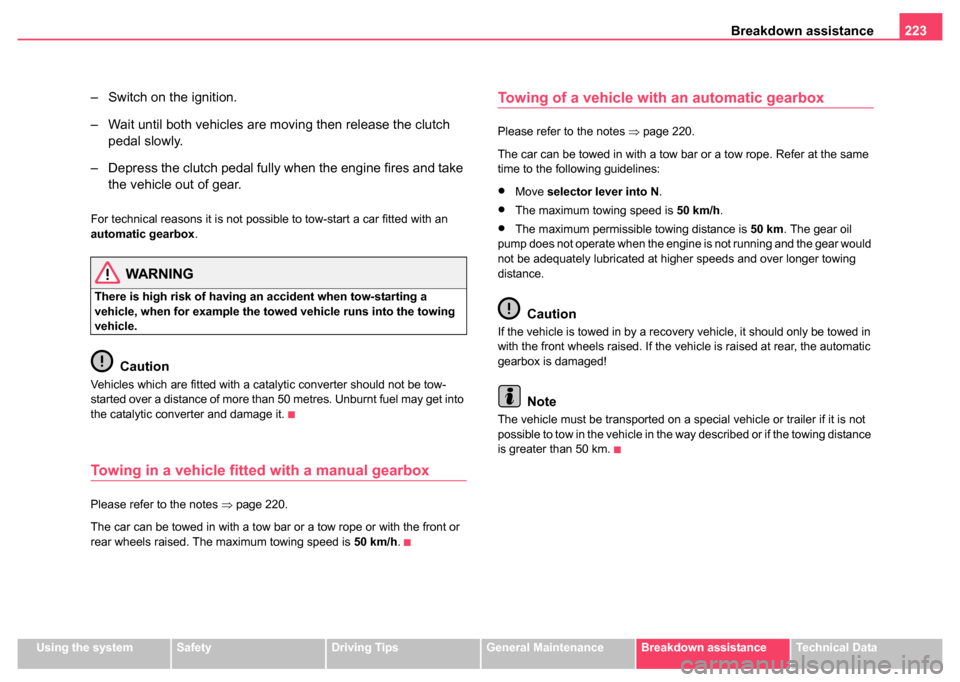
Breakdown assistance223
Using the systemSafetyDriving TipsGeneral MaintenanceBreakdown assistanceTechnical Data
– Switch on the ignition.
– Wait until both vehicles are moving then release the clutch
pedal slowly.
– Depress the clutch pedal fully when the engine fires and take the vehicle out of gear.
For technical reasons it is not possible to tow-start a car fitted with an
automatic gearbox .
WARNING
There is high risk of having an accident when tow-starting a
vehicle, when for example the towe d vehicle runs into the towing
vehicle.
Caution
Vehicles which are fitted with a catalytic converter should not be tow-
started over a distance of more than 50 metres. Unburnt fuel may get into
the catalytic converter and damage it.
Towing in a vehicle fitted with a manual gearbox
Please refer to the notes ⇒page 220.
The car can be towed in with a tow bar or a tow rope or with the front or
rear wheels raised. The maximum towing speed is 50 km/h.
Towing of a vehicle with an automatic gearbox
Please refer to the notes ⇒page 220.
The car can be towed in with a tow bar or a tow rope. Refer at the same
time to the following guidelines:
•Move selector lever into N .
•The maximum towing speed is 50 km/h.
•The maximum permissible towing distance is 50 km. The gear oil
pump does not operate when the engine is not running and the gear would
not be adequately lubricated at higher speeds and over longer towing
distance.
Caution
If the vehicle is towed in by a recovery vehicle, it should only be towed in
with the front wheels raised. If the vehicle is raised at rear, the automatic
gearbox is damaged!
Note
The vehicle must be transported on a special vehicle or trailer if it is not
possible to tow in the vehicle in the way described or if the towing distance
is greater than 50 km.
Page 240 of 247
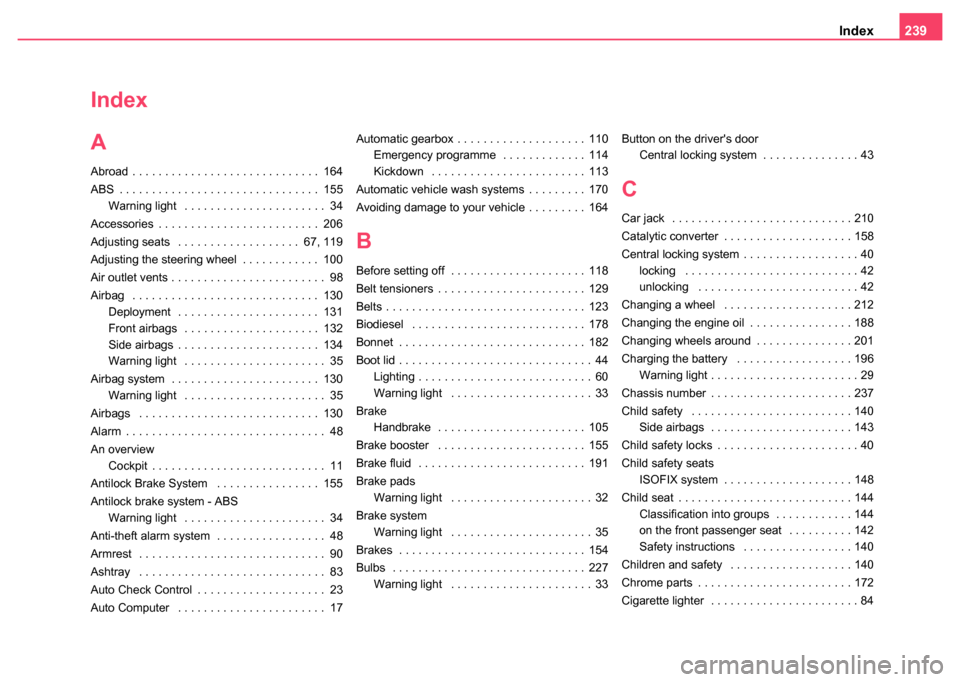
Index239
Index
A
Abroad . . . . . . . . . . . . . . . . . . . . . . . . . . . . . 164
ABS . . . . . . . . . . . . . . . . . . . . . . . . . . . . . . . 155
Warning light . . . . . . . . . . . . . . . . . . . . . . 34
Accessories . . . . . . . . . . . . . . . . . . . . . . . . . 206
Adjusting seats . . . . . . . . . . . . . . . . . . . 67, 119
Adjusting the steering wheel . . . . . . . . . . . . 100
Air outlet vents . . . . . . . . . . . . . . . . . . . . . . . . 98
Airbag . . . . . . . . . . . . . . . . . . . . . . . . . . . . . 130 Deployment . . . . . . . . . . . . . . . . . . . . . . 131
Front airbags . . . . . . . . . . . . . . . . . . . . . 132
Side airbags . . . . . . . . . . . . . . . . . . . . . . 134
Warning light . . . . . . . . . . . . . . . . . . . . . . 35
Airbag system . . . . . . . . . . . . . . . . . . . . . . . 130 Warning light . . . . . . . . . . . . . . . . . . . . . . 35
Airbags . . . . . . . . . . . . . . . . . . . . . . . . . . . . 130
Alarm . . . . . . . . . . . . . . . . . . . . . . . . . . . . . . . 48
An overview Cockpit . . . . . . . . . . . . . . . . . . . . . . . . . . . 11
Antilock Brake System . . . . . . . . . . . . . . . . 155
Antilock brake system - ABS Warning light . . . . . . . . . . . . . . . . . . . . . . 34
Anti-theft alarm system . . . . . . . . . . . . . . . . . 48
Armrest . . . . . . . . . . . . . . . . . . . . . . . . . . . . . 90
Ashtray . . . . . . . . . . . . . . . . . . . . . . . . . . . . . 83
Auto Check Control . . . . . . . . . . . . . . . . . . . . 23
Auto Computer . . . . . . . . . . . . . . . . . . . . . . . 17 Automatic gearbox . . . . . . . . . . . . . . . . . . . . 110
Emergency programme . . . . . . . . . . . . . 114
Kickdown . . . . . . . . . . . . . . . . . . . . . . . . 113
Automatic vehicle wash systems . . . . . . . . . 170
Avoiding damage to your vehicle . . . . . . . . . 164
B
Before setting off . . . . . . . . . . . . . . . . . . . . . 118
Belt tensioners . . . . . . . . . . . . . . . . . . . . . . . 129
Belts . . . . . . . . . . . . . . . . . . . . . . . . . . . . . . . 123
Biodiesel . . . . . . . . . . . . . . . . . . . . . . . . . . . 178
Bonnet . . . . . . . . . . . . . . . . . . . . . . . . . . . . . 182
Boot lid . . . . . . . . . . . . . . . . . . . . . . . . . . . . . . 44 Lighting . . . . . . . . . . . . . . . . . . . . . . . . . . . 60
Warning light . . . . . . . . . . . . . . . . . . . . . . 33
Brake Handbrake . . . . . . . . . . . . . . . . . . . . . . . 105
Brake booster . . . . . . . . . . . . . . . . . . . . . . . 155
Brake fluid . . . . . . . . . . . . . . . . . . . . . . . . . . 191
Brake pads Warning light . . . . . . . . . . . . . . . . . . . . . . 32
Brake system Warning light . . . . . . . . . . . . . . . . . . . . . . 35
Brakes . . . . . . . . . . . . . . . . . . . . . . . . . . . . . 154
Bulbs . . . . . . . . . . . . . . . . . . . . . . . . . . . . . . 227 Warning light . . . . . . . . . . . . . . . . . . . . . . 33 Button on the driver's door
Central locking system . . . . . . . . . . . . . . . 43
C
Car jack . . . . . . . . . . . . . . . . . . . . . . . . . . . . 210
Catalytic converter . . . . . . . . . . . . . . . . . . . . 158
Central locking system . . . . . . . . . . . . . . . . . . 40locking . . . . . . . . . . . . . . . . . . . . . . . . . . . 42
unlocking . . . . . . . . . . . . . . . . . . . . . . . . . 42
Changing a wheel . . . . . . . . . . . . . . . . . . . . 212
Changing the engine oil . . . . . . . . . . . . . . . . 188
Changing wheels around . . . . . . . . . . . . . . . 201
Charging the battery . . . . . . . . . . . . . . . . . . 196 Warning light . . . . . . . . . . . . . . . . . . . . . . . 29
Chassis number . . . . . . . . . . . . . . . . . . . . . . 237
Child safety . . . . . . . . . . . . . . . . . . . . . . . . . 140 Side airbags . . . . . . . . . . . . . . . . . . . . . . 143
Child safety locks . . . . . . . . . . . . . . . . . . . . . . 40
Child safety seats ISOFIX system . . . . . . . . . . . . . . . . . . . . 148
Child seat . . . . . . . . . . . . . . . . . . . . . . . . . . . 144 Classification into groups . . . . . . . . . . . . 144
on the front passenger seat . . . . . . . . . . 142
Safety instructions . . . . . . . . . . . . . . . . . 140
Children and safety . . . . . . . . . . . . . . . . . . . 140
Chrome parts . . . . . . . . . . . . . . . . . . . . . . . . 172
Cigarette lighter . . . . . . . . . . . . . . . . . . . . . . . 84
Page 241 of 247
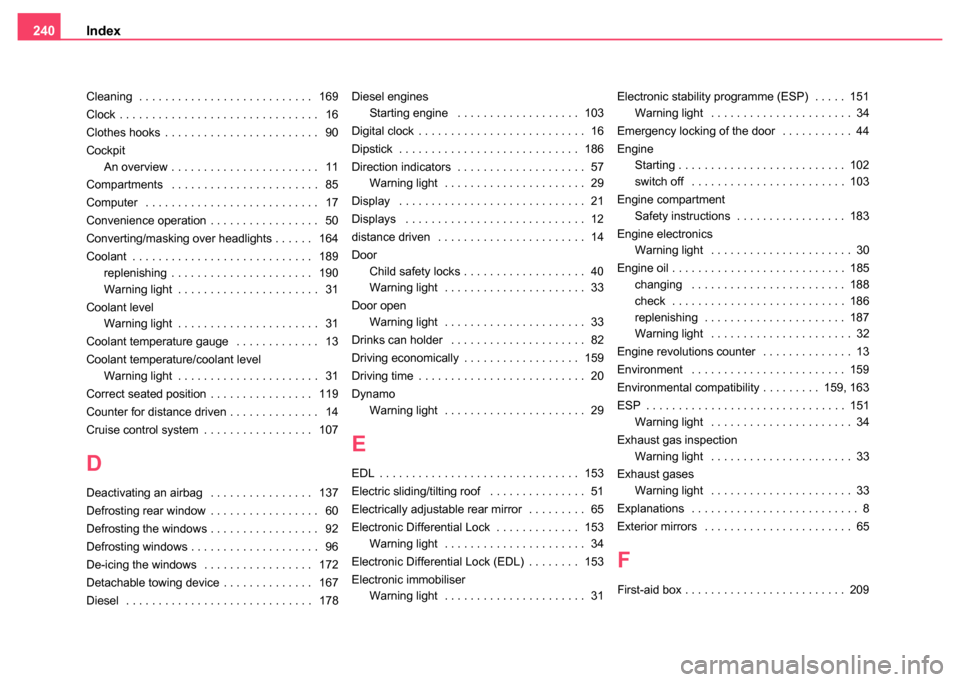
Index
240
Cleaning . . . . . . . . . . . . . . . . . . . . . . . . . . . 169
Clock . . . . . . . . . . . . . . . . . . . . . . . . . . . . . . . 16
Clothes hooks . . . . . . . . . . . . . . . . . . . . . . . . 90
Cockpit
An overview . . . . . . . . . . . . . . . . . . . . . . . 11
Compartments . . . . . . . . . . . . . . . . . . . . . . . 85
Computer . . . . . . . . . . . . . . . . . . . . . . . . . . . 17
Convenience operation . . . . . . . . . . . . . . . . . 50
Converting/masking over headlights . . . . . . 164
Coolant . . . . . . . . . . . . . . . . . . . . . . . . . . . . 189 replenishing . . . . . . . . . . . . . . . . . . . . . . 190
Warning light . . . . . . . . . . . . . . . . . . . . . . 31
Coolant level Warning light . . . . . . . . . . . . . . . . . . . . . . 31
Coolant temperature gauge . . . . . . . . . . . . . 13
Coolant temperature/coolant level Warning light . . . . . . . . . . . . . . . . . . . . . . 31
Correct seated position . . . . . . . . . . . . . . . . 119
Counter for distance driven . . . . . . . . . . . . . . 14
Cruise control system . . . . . . . . . . . . . . . . . 107
D
Deactivating an airbag . . . . . . . . . . . . . . . . 137
Defrosting rear window . . . . . . . . . . . . . . . . . 60
Defrosting the windows . . . . . . . . . . . . . . . . . 92
Defrosting windows . . . . . . . . . . . . . . . . . . . . 96
De-icing the windows . . . . . . . . . . . . . . . . . 172
Detachable towing device . . . . . . . . . . . . . . 167
Diesel . . . . . . . . . . . . . . . . . . . . . . . . . . . . . 178 Diesel engines
Starting engine . . . . . . . . . . . . . . . . . . . 103
Digital clock . . . . . . . . . . . . . . . . . . . . . . . . . . 16
Dipstick . . . . . . . . . . . . . . . . . . . . . . . . . . . . 186
Direction indicators . . . . . . . . . . . . . . . . . . . . 57 Warning light . . . . . . . . . . . . . . . . . . . . . . 29
Display . . . . . . . . . . . . . . . . . . . . . . . . . . . . . 21
Displays . . . . . . . . . . . . . . . . . . . . . . . . . . . . 12
distance driven . . . . . . . . . . . . . . . . . . . . . . . 14
Door Child safety locks . . . . . . . . . . . . . . . . . . . 40
Warning light . . . . . . . . . . . . . . . . . . . . . . 33
Door open Warning light . . . . . . . . . . . . . . . . . . . . . . 33
Drinks can holder . . . . . . . . . . . . . . . . . . . . . 82
Driving economically . . . . . . . . . . . . . . . . . . 159
Driving time . . . . . . . . . . . . . . . . . . . . . . . . . . 20
Dynamo Warning light . . . . . . . . . . . . . . . . . . . . . . 29
E
EDL . . . . . . . . . . . . . . . . . . . . . . . . . . . . . . . 153
Electric sliding/tilting roof . . . . . . . . . . . . . . . 51
Electrically adjustable rear mirror . . . . . . . . . 65
Electronic Differential Lock . . . . . . . . . . . . . 153Warning light . . . . . . . . . . . . . . . . . . . . . . 34
Electronic Differential Lock (EDL) . . . . . . . . 153
Electronic immobiliser Warning light . . . . . . . . . . . . . . . . . . . . . . 31 Electronic stability programme (ESP) . . . . . 151
Warning light . . . . . . . . . . . . . . . . . . . . . . 34
Emergency locking of the door . . . . . . . . . . . 44
Engine Starting . . . . . . . . . . . . . . . . . . . . . . . . . . 102
switch off . . . . . . . . . . . . . . . . . . . . . . . . 103
Engine compartment Safety instructions . . . . . . . . . . . . . . . . . 183
Engine electronics Warning light . . . . . . . . . . . . . . . . . . . . . . 30
Engine oil . . . . . . . . . . . . . . . . . . . . . . . . . . . 185 changing . . . . . . . . . . . . . . . . . . . . . . . . 188
check . . . . . . . . . . . . . . . . . . . . . . . . . . . 186
replenishing . . . . . . . . . . . . . . . . . . . . . . 187
Warning light . . . . . . . . . . . . . . . . . . . . . . 32
Engine revolutions counter . . . . . . . . . . . . . . 13
Environment . . . . . . . . . . . . . . . . . . . . . . . . 159
Environmental compatibility . . . . . . . . . 159, 163
ESP . . . . . . . . . . . . . . . . . . . . . . . . . . . . . . . 151 Warning light . . . . . . . . . . . . . . . . . . . . . . 34
Exhaust gas inspection Warning light . . . . . . . . . . . . . . . . . . . . . . 33
Exhaust gases Warning light . . . . . . . . . . . . . . . . . . . . . . 33
Explanations . . . . . . . . . . . . . . . . . . . . . . . . . . 8
Exterior mirrors . . . . . . . . . . . . . . . . . . . . . . . 65
F
First-aid box . . . . . . . . . . . . . . . . . . . . . . . . . 209
Page 242 of 247
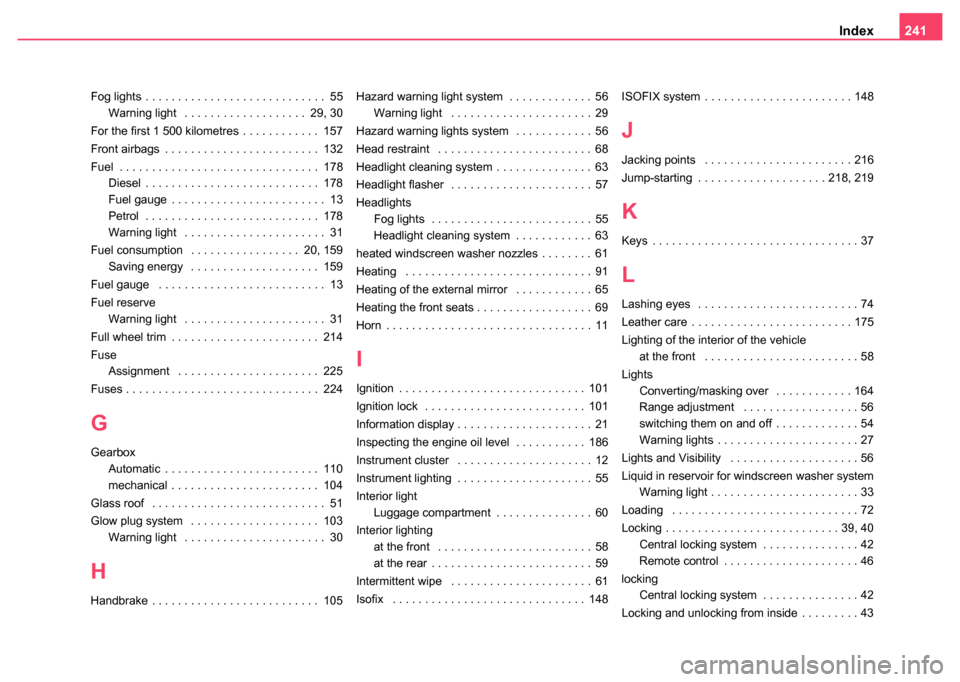
Index241
Fog lights . . . . . . . . . . . . . . . . . . . . . . . . . . . . 55
Warning light . . . . . . . . . . . . . . . . . . . 29, 30
For the first 1 500 kilometres . . . . . . . . . . . . 157
Front airbags . . . . . . . . . . . . . . . . . . . . . . . . 132
Fuel . . . . . . . . . . . . . . . . . . . . . . . . . . . . . . . 178 Diesel . . . . . . . . . . . . . . . . . . . . . . . . . . . 178
Fuel gauge . . . . . . . . . . . . . . . . . . . . . . . . 13
Petrol . . . . . . . . . . . . . . . . . . . . . . . . . . . 178
Warning light . . . . . . . . . . . . . . . . . . . . . . 31
Fuel consumption . . . . . . . . . . . . . . . . . 20, 159 Saving energy . . . . . . . . . . . . . . . . . . . . 159
Fuel gauge . . . . . . . . . . . . . . . . . . . . . . . . . . 13
Fuel reserve Warning light . . . . . . . . . . . . . . . . . . . . . . 31
Full wheel trim . . . . . . . . . . . . . . . . . . . . . . . 214
Fuse Assignment . . . . . . . . . . . . . . . . . . . . . . 225
Fuses . . . . . . . . . . . . . . . . . . . . . . . . . . . . . . 224
G
Gearbox Automatic . . . . . . . . . . . . . . . . . . . . . . . . 110
mechanical . . . . . . . . . . . . . . . . . . . . . . . 104
Glass roof . . . . . . . . . . . . . . . . . . . . . . . . . . . 51
Glow plug system . . . . . . . . . . . . . . . . . . . . 103 Warning light . . . . . . . . . . . . . . . . . . . . . . 30
H
Handbrake . . . . . . . . . . . . . . . . . . . . . . . . . . 105 Hazard warning light system . . . . . . . . . . . . . 56
Warning light . . . . . . . . . . . . . . . . . . . . . . 29
Hazard warning lights system . . . . . . . . . . . . 56
Head restraint . . . . . . . . . . . . . . . . . . . . . . . . 68
Headlight cleaning system . . . . . . . . . . . . . . . 63
Headlight flasher . . . . . . . . . . . . . . . . . . . . . . 57
Headlights Fog lights . . . . . . . . . . . . . . . . . . . . . . . . . 55
Headlight cleaning system . . . . . . . . . . . . 63
heated windscreen washer nozzles . . . . . . . . 61
Heating . . . . . . . . . . . . . . . . . . . . . . . . . . . . . 91
Heating of the external mirror . . . . . . . . . . . . 65
Heating the front seats . . . . . . . . . . . . . . . . . . 69
Horn . . . . . . . . . . . . . . . . . . . . . . . . . . . . . . . . 11
I
Ignition . . . . . . . . . . . . . . . . . . . . . . . . . . . . . 101
Ignition lock . . . . . . . . . . . . . . . . . . . . . . . . . 101
Information display . . . . . . . . . . . . . . . . . . . . . 21
Inspecting the engine oil level . . . . . . . . . . . 186
Instrument cluster . . . . . . . . . . . . . . . . . . . . . 12
Instrument lighting . . . . . . . . . . . . . . . . . . . . . 55
Interior light Luggage compartment . . . . . . . . . . . . . . . 60
Interior lighting at the front . . . . . . . . . . . . . . . . . . . . . . . . 58
at the rear . . . . . . . . . . . . . . . . . . . . . . . . . 59
Intermittent wipe . . . . . . . . . . . . . . . . . . . . . . 61
Isofix . . . . . . . . . . . . . . . . . . . . . . . . . . . . . . 148 ISOFIX system . . . . . . . . . . . . . . . . . . . . . . . 148
J
Jacking points . . . . . . . . . . . . . . . . . . . . . . . 216
Jump-starting . . . . . . . . . . . . . . . . . . . . 218, 219
K
Keys . . . . . . . . . . . . . . . . . . . . . . . . . . . . . . . . 37
L
Lashing eyes . . . . . . . . . . . . . . . . . . . . . . . . . 74
Leather care . . . . . . . . . . . . . . . . . . . . . . . . . 175
Lighting of the interior of the vehicle
at the front . . . . . . . . . . . . . . . . . . . . . . . . 58
Lights Converting/masking over . . . . . . . . . . . . 164
Range adjustment . . . . . . . . . . . . . . . . . . 56
switching them on and off . . . . . . . . . . . . . 54
Warning lights . . . . . . . . . . . . . . . . . . . . . . 27
Lights and Visibility . . . . . . . . . . . . . . . . . . . . 56
Liquid in reservoir for windscreen washer system Warning light . . . . . . . . . . . . . . . . . . . . . . . 33
Loading . . . . . . . . . . . . . . . . . . . . . . . . . . . . . 72
Locking . . . . . . . . . . . . . . . . . . . . . . . . . . . 39, 40 Central locking system . . . . . . . . . . . . . . . 42
Remote control . . . . . . . . . . . . . . . . . . . . . 46
locking Central locking system . . . . . . . . . . . . . . . 42
Locking and unlocking from inside . . . . . . . . . 43